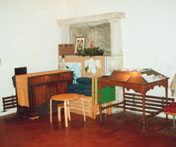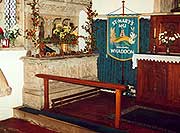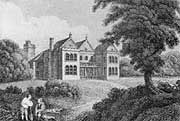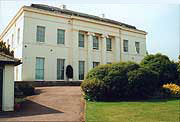|
 |
 |
 |
 |
 |
 |
 |
 |
 |
 |
 |
 |
 |
 |
 |
 |
 |
 |
 |
Department Electra House - Whaddon Hall
|
|
 |
 |
|
|
|
|
|
|
|
|
|
|
|
|
|
|
|
 |
|
|
|
|
|
An early dwelling on the site of the present Whaddon Hall was once the home of the Pigott family, who came to the manor by marriage into the Giffard family. The Giffards had acquired the manor as a reward for their military service at the Conquest and a fine memorial may be seen in Whaddon church. In 1552 William Lord Grey de Wilton acquired the interest but during military service in France he was captured and only secured his release on the payment of a large ransom. His son Arthur therefore inherited a greatly impoverished family fortune when William died in 1552.
Arthur had the choice of two homes, Water Hall at Fenny Stratford or Whaddon Hall. He chose Whaddon Hall and had Water Hall taken down, |
|
 |
 |
|
 |
|
Tomb of Arthur de Grey |
|
|
 |
to provide building materials for enhancing his new home. All the waggon teams in the county were needed for the task and they formed a convoy two miles long! The finished result was a mansion of grand proportions and even Queen Elizabeth 1st. stayed on more than one occasion. Perhaps in a recognition of this hospitality she created him Lord Lieutenant of Ireland although his increasingly violent means, applied during his term of office, caused her a mounting displeasure. Arthur died at Whaddon on October 14th., 1593 and his large and eroded stone tomb, that carries an inscription to his life achievements, may be seen in Whaddon church. Arthur’s son Thomas inherited the manor but for plotting against the new monarch, James 1st., then found
himself imprisoned in the Tower of London and there he died in 1614. |
|
|
|
|
|
|
|
 |
|
 |
|
 |
|
|
Pigott Family Tomb |
|
|
|
 |
Thomas had no children and eventually the estates were granted by the Crown to the King’s favourite, George Villiers, who became, also by royal favour, the Duke of Buckingham. He was murdered at Portsmouth and his son, the second Duke, lost the estates to Cromwell at Parliament’s victory in the Civil War. The Duke then fled abroad but eventually returned and in 1657 married Mary Fairfax, the daughter of the Parliamentary General to whom the Duke’s estates had been granted! No sooner did the couple make their home at Whaddon Hall than the Duke was banished to the Tower and although he regained the estates at the Restoration because of his spendthrift ways he died, impoverished, in 1687. The estates then had to be sold off to pay the debts.
Whaddon was consequently purchased in 1698 by James Selby of Wavendon Manor and Thomas Willis and the agreement awarded 2/3rds. to Selby and the remainder to Willis. This not only applied to the estates but also to the Hall which being ‘a miserable and gloomy place’, they both decided to demolish. Yet Browne Willis, the son of Thomas, after his father’s death decided to renovate the family share and purchasing the remainder from Selby began to make reconstructions. After the death of Browne Willis the Hall was then sold to Thomas Selby who bequeathed the Hall to his great friend William Lowndes, of Winslow, on condition that he assumed the surname of Lowndes-Selby. |
|
|
 |
|
|
 |
|
 |
|
|
|
 |
|
|
|
Old Whaddon Hall |
|
|
|
Whaddon Hall Today |
|
|
|
|
 |
In 1783 William took possession of the Hall and in due course his son reversed the surname to Selby-Lowndes. The family eventually preferred to make their home at Winslow and Whaddon Hall fell into decay, to be eventually demolished. The present Hall represents a re-building by the family in 1820.
After the Second World War the Hall was purchased by the Merchant Venturers of Bristol for £50,000 and in time became a country club. Badly damaged by a fire , with much of the interior destroyed, the mansion has lately been converted into luxury flats. |
|
|
 |
|
|
|
|
|
|
|
Back to top |
|
|
|
|
|
|
|
|




